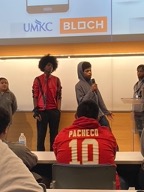Real World Learning: Business Reflection
Written by: Zachary Johnson, North Kansas City Schools
Slowing down to reflect can be viewed with a negative connotation in learning. The word “coverage” is especially triggering for teachers who have dreams of doing authentic, client-connected projects. If only we didn’t have all of this content to “cover.”
The act of reflection should not be viewed as a step backward in learning but as an essential element of the learning process. It not only creates new neural connections for students but is also a key element in preventing students from using artificial intelligence to create work for them, with little effect on their learning. As Sarah Field from PBLWorks has stated, reflection should vary to include thoughts on the content being learned, the process being used, the purpose of the work, and the individual involved in the learning.
Reflection on the content involves students asking questions centered on the question of “What am I learning?” As Field wrote, “Reflecting on content helps students build schema about core concepts within and across disciplines, so they can integrate new knowledge and use it.”
Reflection on the process involves students asking questions such as this: “How am I learning and is it working?” Reflection on the process of learning helps students become more flexible and adaptable to changes in project work.
Reflection on the purpose of learning involves students asking questions such as this: “Why are we doing this?” To help motivate students in their learning, we must help them reflect on the underlying purpose of their learning and provide opportunities for meaningful work.
Last, students should reflect on themselves as learners and ask questions such as this: “Who am I and how am I growing as a learner?” Reflection on ourselves helps students lead their own learning and build culture in the classroom.
Reflection is one piece that we prioritized while working with the apprenticeship program. We have planned how to provide students with opportunities to work through projects for real-world clients, but the real learning and growth take place when students look at what they have accomplished, the skills they have gained, and how they have grown. This reflection looks different in each of our classrooms but is still a vital part of the learning process.

Katy Bergeron from the Hickman-Mills School District has been working with her business class on starting a coffee shop. “The process of developing a plan of action to determine the best assessment of risk within the shop was a wonderful critical thinking and problem-solving process. The students identified that product liability law within civil law would be the best curriculum connection to work with. We started identifying the problem that we would need to address with help from a product liability lawyer and began communicating with him. We learned at the end of the first quarter that the coffee shop would sell prepackaged items and not be available to the public but more of a school store run by the CORE program. We stopped work on the project to regroup and pivot. This was a valuable learning lesson for me and my students because they quickly learned that in real-world situations sometimes you fail, start over, regroup, and/ or pivot and now we are doing a totally different banking project.”
Zachary Jonson from the North Kansas City School District said, “I have students create LinkedIn accounts at the beginning of the year to act as a living document for them and something they can take with them. We try to at least once per month take a break to look back on what they have been doing, what they’ve accomplished, skills they’ve gained, or people they’ve worked with and make sure that is documented in their profiles. Also sitting down with students to have them share what they have enjoyed about the project thus far, or have learned can help them see to look at how far they’ve come or how they have personally grown through the process. It’s amazing to see the confidence they gain through this and great to see their reactions as this is all brought together at the end of the project or the school year.”
Kara Kestner of the Raymore-Peculiar LEAD Center Enterprise & Design program said “A fundamental aspect of students’ CCP work is reflecting on their experiences. Students submit artifacts including documents, videos, pictures, and so on, showcasing their project work to highlight the target or skill learned. For each target, they also reflect on how the artifact aligns with the target or skill, helping them to create a deeper connection to their learning and experiences.”
We have outlined four different ways that students can reflect on their learning at the end of projects or throughout a course. This time can be instrumental to their learning and growth. Challenge yourself to try one of these types of reflection in your classroom, or if you’re already using reflection, try a new strategy.
Source: PBLworks.org
